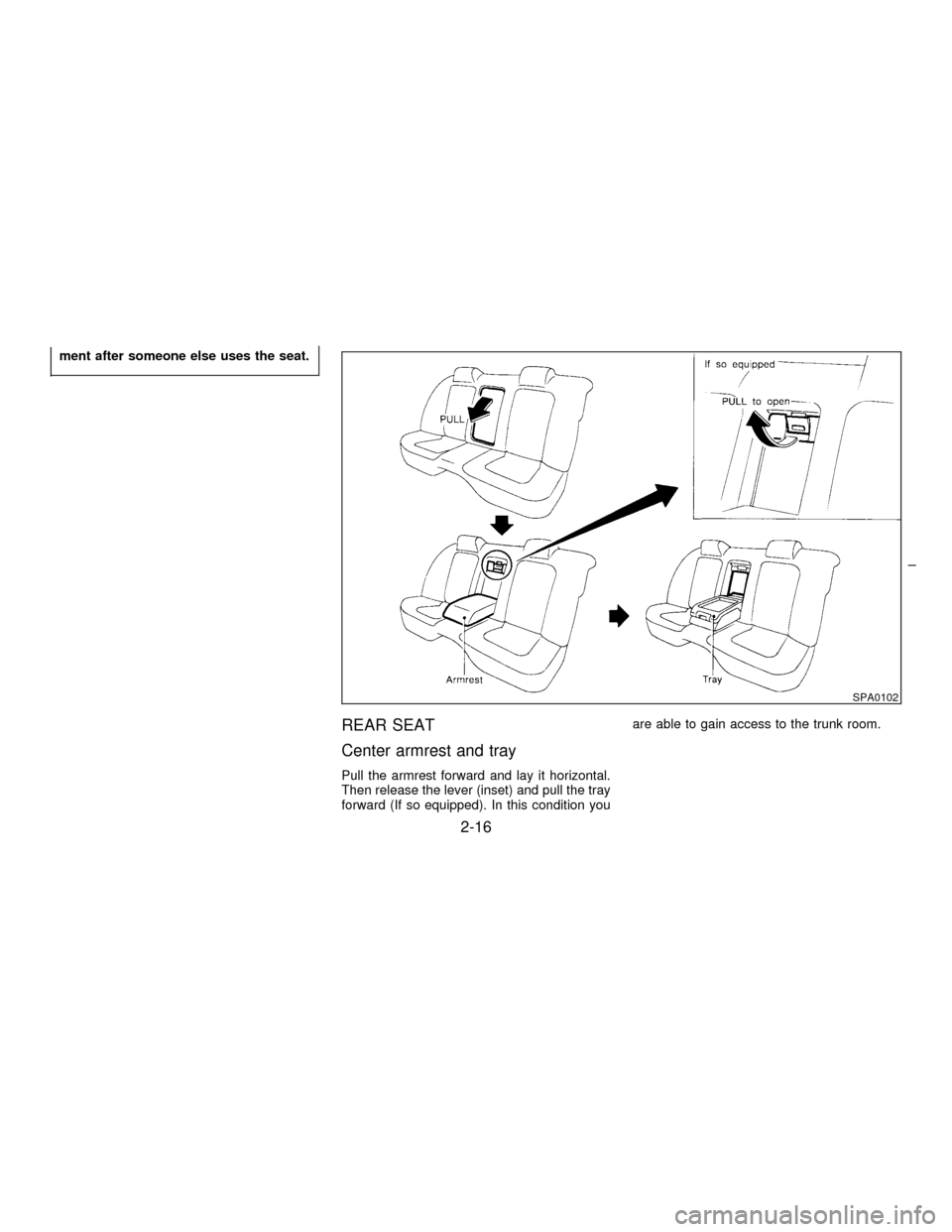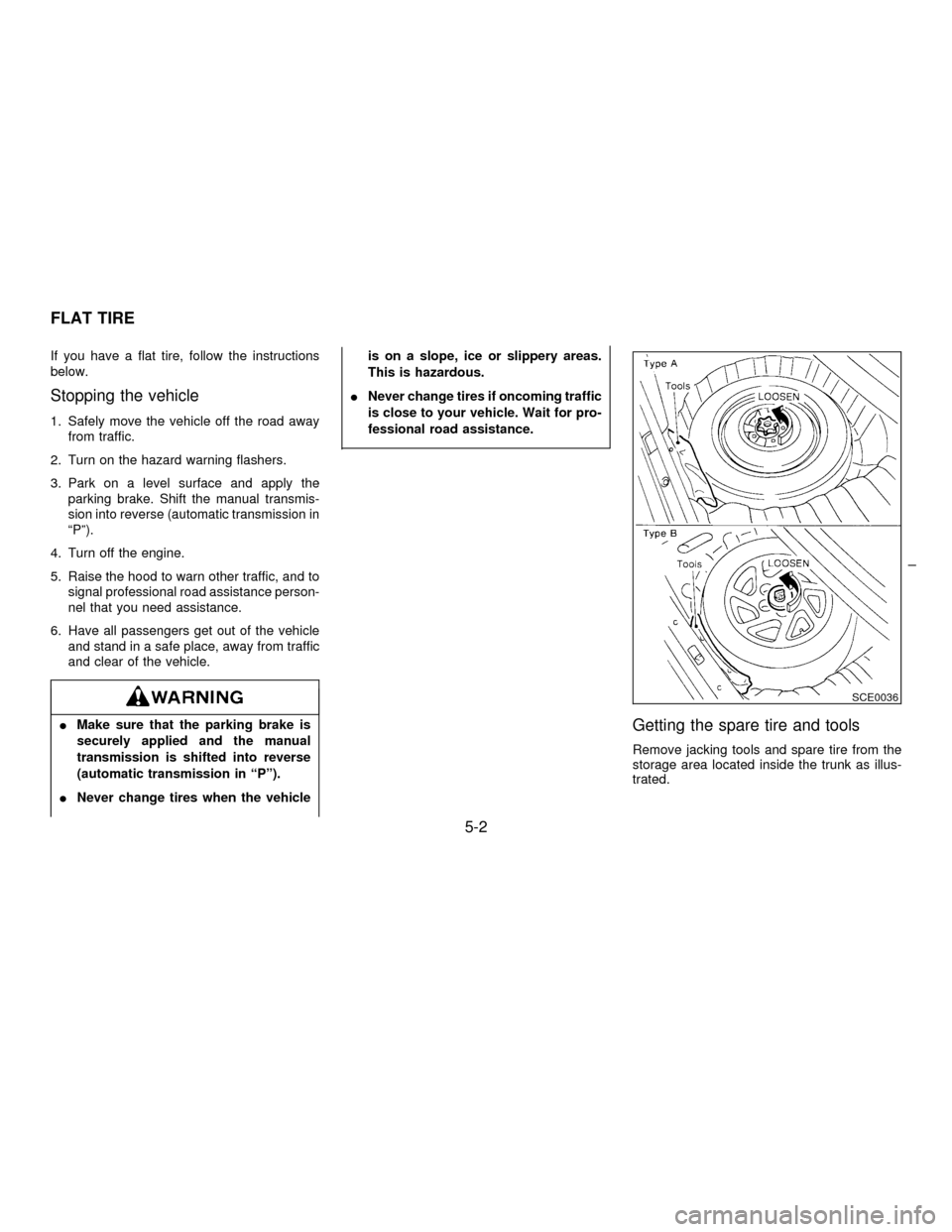1997 NISSAN MAXIMA trunk
[x] Cancel search: trunkPage 43 of 215

OPENER CANCEL LEVER FOR
TRUNK LID
When the lever is in the ªCANCELº position,
the trunk lid cannot be opened with the trunk
lid release lever or handle. It can be opened
only with the key.
Opener lever
Type A
To open the fuel filler lid, pull the opener lever.
To lock, close the fuel filler lid securely.
Type B
To open the fuel filler lid, push the opener lever
down. To lock, close the fuel filler lid securely.
FUEL FILLER CAP
The fuel filler cap is a screw-on ratcheting
type. Tighten the cap clockwise until ratcheting
clicks are heard.
IGasoline is extremely flammable and
highly explosive under certain condi-
tions. You could be burned or seri-
ously injured if it is misused or mis-
handled. Always stop the engine and
do not smoke or allow open flames or
SPA0095SPA0096SPA0119
FUEL FILLER LID LOCK
2-10
Z01.2.1/A32-DX
Page 49 of 215

ment after someone else uses the seat.
REAR SEAT
Center armrest and tray
Pull the armrest forward and lay it horizontal.
Then release the lever (inset) and pull the tray
forward (If so equipped). In this condition youare able to gain access to the trunk room.
SPA0102
2-16
Z01.2.1/A32-DX
Page 69 of 215

Anchor point locations
Anchor points are located under the rear par-
cel shelf finisher.
To use attaching hardware for child restraints
with top straps, follow these instructions care-
fully:
1. Open the trunk and find the anchor point
nuts on the under side of the rear parcel
shelf. Thread a bolt (8.0 mm diameter, 1.25
pitch) up through the nut behind the seating
position where the child restraint will be
installed and use it to break through the
rear parcel shelf support material. Thereare pre-cut circles at each anchor point
location that should break away from the
shelf support material when pressure is
applied to them. Remove the bolt after you
feel the pre-cut circle separate from the
shelf support material.
2. Cut a small slit through the parcel shelf
fabric at the anchor point location. Reach
through the fabric with a tool such as a pair
of needle-nose pliers and remove the pre-
cut circle in the parcel shelf support mate-
rial.
3. Install the bolt through the top strap hook
and into the anchor point nut.
4. Be sure to follow all of the instructions that
accompany the top strap attaching hard-
ware.
Your NISSAN dealer can assist you with the
installation of your child restraint.
SPA0117
2-36
Z01.2.1/A32-DX
Page 105 of 215

Do not leave children, unreliable adults,
or pets alone in your vehicle. They could
accidentally injure themselves or others
through inadvertent operation of the ve-
hicle. Also, on hot, sunny days, tem-
peratures in a closed vehicle could
quickly become high enough to cause
severe or possibly fatal injuries to
people or animals.
EXHAUST GAS (Carbon Monoxide)
Do not breathe exhaust gases; they con-
tain colorless and odorless carbon mon-
oxide. Carbon monoxide is dangerous. It
can cause unconsciousness or death.
IIf you suspect that exhaust fumes are
entering the vehicle, drive with all
windows fully open, and have the
vehicle inspected immediately.
IDo not run the engine in closed
spaces such as a garage.IDo not park the vehicle with the en-
gine running for any extended length
of time.
IKeep the trunk lid, or back door
closed while driving, otherwise ex-
haust gases could be drawn into the
passenger compartment. If you must
drive in this manner for some reason,
take the following steps.
1. Open all the windows.
2. Set the air recirculate switch
ªOFFº and the fan control at
ªhighº to circulate the air.
3. Be sure the rear seat armrest and
tray are closed.
IIf electrical wiring or other cable con-
nections must pass to a trailer
through the seal on the trunk lid or
the body, follow the manufacturer's
recommendation to prevent carbon
monoxide entry into the vehicle.
IIf a special body or other equipment
is added for recreational or other us-
age, follow the manufacturer's rec-
ommendation to prevent carbonmonoxide entry into the vehicle.
(Some recreational vehicle appli-
ances such as stoves, refrigerator,
heaters, etc. may also generate car-
bon monoxide.)
IThe exhaust system and body should
be inspected by a qualified mechanic
whenever:
a. The vehicle is raised for service.
b. You suspect that exhaust fumes
are entering into the passenger
compartment.
c. You notice a change in the sound
of the exhaust system.
d. You have had an accident involv-
ing damage to the exhaust system,
underbody, or rear of the vehicle.
THREE WAY CATALYST
The three way catalyst is an emission control
device installed in the exhaust system. Ex-
haust gases in the converter are burned at
high temperatures to help reduce pollutants.
PRECAUTIONS WHEN STARTING
AND DRIVING
4-2
Z01.2.1/A32-DX
Page 127 of 215

If you have a flat tire, follow the instructions
below.
Stopping the vehicle
1. Safely move the vehicle off the road away
from traffic.
2. Turn on the hazard warning flashers.
3. Park on a level surface and apply the
parking brake. Shift the manual transmis-
sion into reverse (automatic transmission in
ªPº).
4. Turn off the engine.
5. Raise the hood to warn other traffic, and to
signal professional road assistance person-
nel that you need assistance.
6. Have all passengers get out of the vehicle
and stand in a safe place, away from traffic
and clear of the vehicle.
IMake sure that the parking brake is
securely applied and the manual
transmission is shifted into reverse
(automatic transmission in ªPº).
INever change tires when the vehicleis on a slope, ice or slippery areas.
This is hazardous.
INever change tires if oncoming traffic
is close to your vehicle. Wait for pro-
fessional road assistance.Getting the spare tire and tools
Remove jacking tools and spare tire from the
storage area located inside the trunk as illus-
trated.
SCE0036
FLAT TIRE
5-2
Z01.2.1/A32-DX
Page 167 of 215

Replacing the headlight bulb
1. Insert the bulb into the headlight reflector
with the flat side of the plastic base facing
upward.
2. Install the bulb retaining ring and turn it
clockwise until it stops.
3. Push the electrical connector into the bulb
plastic base until it snaps and stops.
4. Connect the battery negative cable.
DO NOT TOUCH THE BULB.
IUse the same number and wattage as
originally installed:
Wattage 65/45
Bulb no. 9004
IAiming is not necessary after replac-
ing the bulb. When aiming adjust-
ment is necessary, contact your
NISSAN dealer.
IDo not leave the bulb out of the head-
light reflector for a long period of time
as dust, moisture, and smoke may
enter the headlight body and affect
the performance of the headlight.
OTHER LIGHTS
Item Wattage (W) Bulb No.
Clearance 27/8 1157
Front turn signal light 27 1156
Front side marker light 3.8 194
Front fog light 55
Rear combination light
Turn signal 27 1156
Stop/Tail 27/8 1157
Back-up 18 921
Rear side marker light 3.8 194
License plate light 5
High-mounted stop light 27 1156
Interior light 10
Front personal light 10
Step light 2.7 161
Trunk light 3.4 158
Vanity mirror light 1.4 Ð
7-24
Z01.2.1/A32-DX
Page 180 of 215

During the normal day-to-day operation of the
vehicle, general maintenance should be per-
formed regularly as prescribed in this section.
If you detect any unusual sounds, vibrations or
smell, be sure to check for the cause or have
your NISSAN dealer do it promptly. In addition,
you should notify your NISSAN dealer if you
think that repairs are required.
When performing any checks or maintenance
work, closely observe the precautions in the
ªDo-it-yourself operationsº section.
Additional information on the following
items with ª*º is found in the ªDo-it-
yourself operationsº section.
OUTSIDE THE VEHICLE
The maintenance items listed here should be
performed from time to time, unless otherwise
specified.
Tires*Check the pressure with a gauge peri-
odically when at a service station, including the
spare, and adjust to the specified pressure if
necessary. Check carefully for damage, cuts
or excessive wear.
Wheel nuts*When checking the tires, make
sure no nuts are missing, and check for any
loose nuts. Tighten if necessary.
Tire rotation*Tires should be rotated every7,500 miles (12,000 km).
Wheel alignment and balanceIf the vehicle
pulls to either side while driving on a straight
and level road, or if you detect uneven or
abnormal tire wear, there may be a need for
wheel alignment.
If the steering wheel or seat vibrates at normal
highway speeds, wheel balancing may be
needed.
Windshield wiper blades*Check for cracks
or wear if they do not wipe properly.
Doors and engine hoodCheck that all doors
and the engine hood operate smoothly as well
as the trunk lid or back hatch. Also make sure
that all latches lock securely. Lubricate if nec-
essary. Make sure that the secondary latch
keeps the hood from opening when the pri-
mary latch is released.
When driving in areas using road salt or other
corrosive materials, check lubrication fre-
quently.
INSIDE THE VEHICLE
The maintenance items listed here should be
checked on a regular basis, such as when
performing periodic maintenance, cleaning the
vehicle, etc.
Lights*Make sure that the headlights, stop
lights, tail lights, turn signal lights, and other
lights are all operating properly and installed
securely. Also check headlight aim.
Warning lights and buzzers/chimesMake
sure that all warning lights and buzzers/chimes
are operating properly.
Windshield wiper and washer*Check that
the wipers and washer operate properly and
that the wipers do not streak.
Windshield defrosterCheck that the air
comes out of the defroster outlets properly and
in good quantity when operating the heater or
air conditioner.
Steering wheelCheck that it has the specified
play. Be sure to check for changes in the
steering conditions, such as excessive play,
hard steering or strange noises.
SeatsCheck seat position controls such as
seat adjusters, seatback recliner, etc. to make
sure they operate smoothly and that all latches
lock securely in every position. Check that the
GENERAL MAINTENANCE
8-3
Z01.2.1/A32-DX
Page 212 of 215

Light bulbs ................................................. 7-23
Supplemental air bag warning light........... 2-22
Trunk light.................................................. 1-23
Vanity mirror light ...................................... 1-23
Warning/indicator light and buzzer.............. 1-6
Lock
Anti-lock brake system (ABS) (If so
equipped)................................................... 4-18
Child safety rear door lock .......................... 2-3
Door lock operation ..................................... 2-6
Door locks ................................................... 2-2
Door unlock operation ................................. 2-6
Fuel filler lid lock ....................................... 2-10
Glove box lock............................................. 2-8
Power door lock .......................................... 2-4
Trunk lid lock ............................................... 2-9
Luggage (ªSee Vehicle loading informationº) . 9-13
M
Maintenance
Explanation of maintenance items ............ 8-10
General maintenance .................................. 8-3
Maintenance precautions ............................ 7-2
Periodic maintenance .................................. 8-5
Readiness for inspection/maintenance (I/M)
test (For U.S.A.) ........................................ 9-19
Seat belt maintenance .............................. 2-31
Meters and gauges ........................................... 1-3
Mirror
Foldable outside mirrors............................ 2-39
Inside mirror .............................................. 2-40
Outside mirror remote control ................... 2-39Rear window and outside mirror defogger
switch......................................................... 1-13
Vanity mirror light ...................................... 1-23
Multi-remote control system (If so equipped) ... 2-5
O
Odometer .......................................................... 1-4
Oil
Changing engine oil .................................... 7-8
Changing oil filter ........................................ 7-9
Checking engine oil level ............................ 7-7
Engine oil..................................................... 7-7
Engine oil and oil filter
recommendation .......................................... 9-4
Opener cancel lever for trunk lid .................... 2-10
Opening the driver's and front passenger's
window .............................................................. 2-6
Operating the transmitter ................................ 1-25
Outside mirror remote control ......................... 2-39
Overheat
If your vehicle overheats ............................. 5-9
P
Panic alarm operation ....................................... 2-6
Parking
Parking brake ................................... 4-12, 7-19
Parking/parking on hills ............................. 4-16
Periodic maintenance ....................................... 8-5
Pocket ............................................................. 1-18
Power
Power antenna .......................................... 3-29
Power door lock .......................................... 2-4Power steering fluid................................... 7-11
Power steering system .............................. 4-17
Power support seat (If so equipped)......... 2-14
Power window ........................................... 1-19
Precautions
Maintenance precautions ............................ 7-2
Precautions on seat belt usage ................ 2-24
Precautions when starting and driving ........ 4-2
Pregnant women............................................. 2-26
Programming problem diagnosis .................... 1-25
Programming the HomeLink
transmitter .................................................. 1-24Push starting ..................................................... 5-9
R
Radio............................................................... 3-11
CB radio or car phone............................... 3-29
FM/AM radio with cassette player............. 3-12
FM-AM radio with cassette
player ......................................................... 3-16
FM-AM radio with cassette player and
compact disc player .................................. 3-22
Radio operation ......................................... 3-23
Readiness for inspection/maintenance (I/M) test
(For U.S.A.)..................................................... 9-19
Rear seat ........................................................ 2-16
Rear window and outside mirror defogger
switch .............................................................. 1-13
Recommended SAE viscosity number ............. 9-6
Refrigerant recommendation ............................ 9-6
Reporting safety defects (For U.S.A.) ............ 9-19
Rolling codes (If so equipped) ........................ 1-26
10-3
Z01.2.1/A32-DX